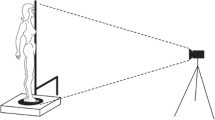Abstract
Purpose
To investigate the effects of four office chairs on the postural angles of the lumbopelvic and cervical regions.
Research question
Which chair(s) produce an “ideal” spinal posture?
Methods
An experimental same subject design was used involving healthy subjects (n = 14) who conducted a typing task whilst sitting on four different office chairs; two “dynamic” chairs (Vari-Kneeler and Swopper), and two static chairs (Saddle and Standard Office with back removed). Data collection was via digital photogrammetry, measuring pelvic and lumbar angles, neck angle and head tilt which were then analysed within MatLab. A repeated measures ANOVA with Bonferroni corrections for multiple comparisons was conducted.
Results
Statistically significant differences were identified for posterior pelvic tilt and lumbar lordosis between the Vari-Kneeler and Swopper chairs (p = 0.006, p = 0.001) and the Vari-Kneeler and Standard Office chairs (p = 0.000, 0.000); and also for neck angle and head tilt between the Vari-Kneeler and Swopper chairs (p = 0.000, p = 0.000), the Vari-Kneeler and Saddle chairs (p = 0.002, p = 0.001), the Standard Office and Swopper chairs (p = 0.000, p = 0.000), and the Standard Office and Saddle chairs (p = 0.005, p = 0.001). This study confirms a within region association between posterior pelvic tilt and lumbar lordosis, and between neck angle and head tilt. It was noted that an ideal lumbopelvic position does not always result in a corresponding ideal cervical position resulting in a spinal alignment mismatch.
Conclusion
In this study, the most appropriate posture for the lumbopelvic region was produced by the Saddle chair and for the cervical region by both the Saddle and Swopper chairs. No chair consistently produced an ideal posture across all regions, although the Saddle chair created the best posture of those chairs studied. Chair selection should be based on individual need.




Similar content being viewed by others
References
Lis A, Black K, Kom H, Nordin M (2006) Association between sitting and low back pain. Eur Spine J 16(2):283–298
Pincus T, Vlaeyen J, Kendall N, Von Korff M, Kalauokalani D, Reis M (2002) Cognitive-behavioral therapy and psychosocial factors in low back pain: directions for the future. Spine 27(5):E133–E138
Airaksinen O, Brox J, Cedraschi C, Hildebrandt J, Klaber-Moffett J, Kovacs F, Mannion A, Reis S, Staal J, Ursin H, Zanoli G (2004) European Guidelines for the Management of Chronic Non Specific Low Back Pain. http://www.backpaineurope.org/web/files/WG2_Guidelines.pdf. Accessed 25 Jan 2012
van Tulder M, Becker A, Bekkering T, Breen A, Teresa Gil del Real M, A, Hutchinson A, Koes B, Laerum E, Malmivaara A (2004) European Guidelines for the Management of Chronic Non Specific Low Back Pain in Primary Care. http://www.backpaineurope.org/web/files/WG1_Guidelines.pdf. Accessed 25 Jan 2012
National Institute for Health and Clinical Excellence (2009) Low Back Pain. Early management of persistent non-specific low back pain. http://www.nice.org.uk/nicemedia/live/11887/44343/44343.pdf. Accessed 25 Jan 2012
Silva A, Punt T, Sharples P, Vilas-Voas J, Johnson M (2009) Head posture assessment for patients with neck pain: is it useful? Int J Ther Rehabil 16(1):41–53
Health and Safety Executive (2011) Musculoskeletal disorders. http://www.hse.gov.uk/statistics/causdis/musculoskeletal/msd.pdf. Accessed 25 Jan 2012
Szeto GPY, Straker L, Raine S (2002) A field comparison of neck and shoulder postures in symptomatic and asymptomatic office workers. Appl Ergonomics 33:75–84
Pynt J, Mackey MG, Higgs J (2008) Kyphosed seated postures: extending concepts of postural health beyond the office. J Occup Rehabil 18(1):35–45
Panjabi M (1992) The stabilizing system of the spine. Part 1: function, dysfunction, application and enhancement. J Spinal Disord 5(4):383–389
Panjabi M (1992) The stabilizing system of the spine. Part II. Neutral Zone and Instability Hypothesis. J Spinal Disord 5(4):390–396
Burnett A, O’Sullivan P, Ankarberg L, Gooding M, Nelis R, Offerman M, Persson J (2008) Lower lumbar spine axial rotation is reduced in end range sagittal postures when compared to a neutral spine posture. Man Ther 13:300–306
Gandavadi A, Ramsay JR, Burke FJ (2006) Assessment of dental student posture in two seating conditions using RULA methodology—a pilot study. Br Dent J 203(10):601–605
Gadge K, Innes E (2006) An investigation into the immediate effects on comfort, productivity and posture of the BambachTM saddle seat and a standard office chair. Work 29(3):189–203
Bettany-Saltikov J, Warren J, Jobson M (2008) Ergonomically designed kneeling chairs are they worth it?: Comparison of sagittal lumbar curvature in two different seating postures. Stud Health Technol Inform 140:103–106
Hicks C (1999) Research methods for clinical therapists: applied project design and analysis, 3rd edn. Churchill Livingstone, Edinburgh
Saad K, Colombo A, Joao S (2009) Reliability and validity of photogrammetry for scoliosis evaluation: a cross sectional prospective study. J Manip Physiol Ther 32(6):423–429
Jones U, Sparkes V, Busse M, Enright S, van Deursen R. (2011) Reliability of digital analysis of thoracic, neck angle and head tilt measurements. J Bone Joint Surg B 93(Suppl IV):490
vanNiekerk S, Lowe Q, Vaughan C, Grimmer-Somers K, Shreve K (2008) Photographic measurement of upper body posture of high school students: a reliability and validity study. BMC Musculoskelet Disorders 9:113
Sheeran L, Sparkes V (2006) The effect of core stability training on the spinal-pelvic stability during running and on the single leg-hop-for-distance performance test in female runners—preliminary study. http://www.somed.org/symp021206/abstracts.pdf. Accessed 22 Dec 2011
Acknowledgments
Authors thank Back in Action (Bristol) for the loan of the Vari-Kneeler and Swopper and Bambach for loaning the Saddle and adjustable desk.
Conflict of interest
None.
Author information
Authors and Affiliations
Corresponding author
Rights and permissions
About this article
Cite this article
Annetts, S., Coales, P., Colville, R. et al. A pilot investigation into the effects of different office chairs on spinal angles. Eur Spine J 21 (Suppl 2), 165–170 (2012). https://doi.org/10.1007/s00586-012-2189-z
Received:
Revised:
Accepted:
Published:
Issue Date:
DOI: https://doi.org/10.1007/s00586-012-2189-z




